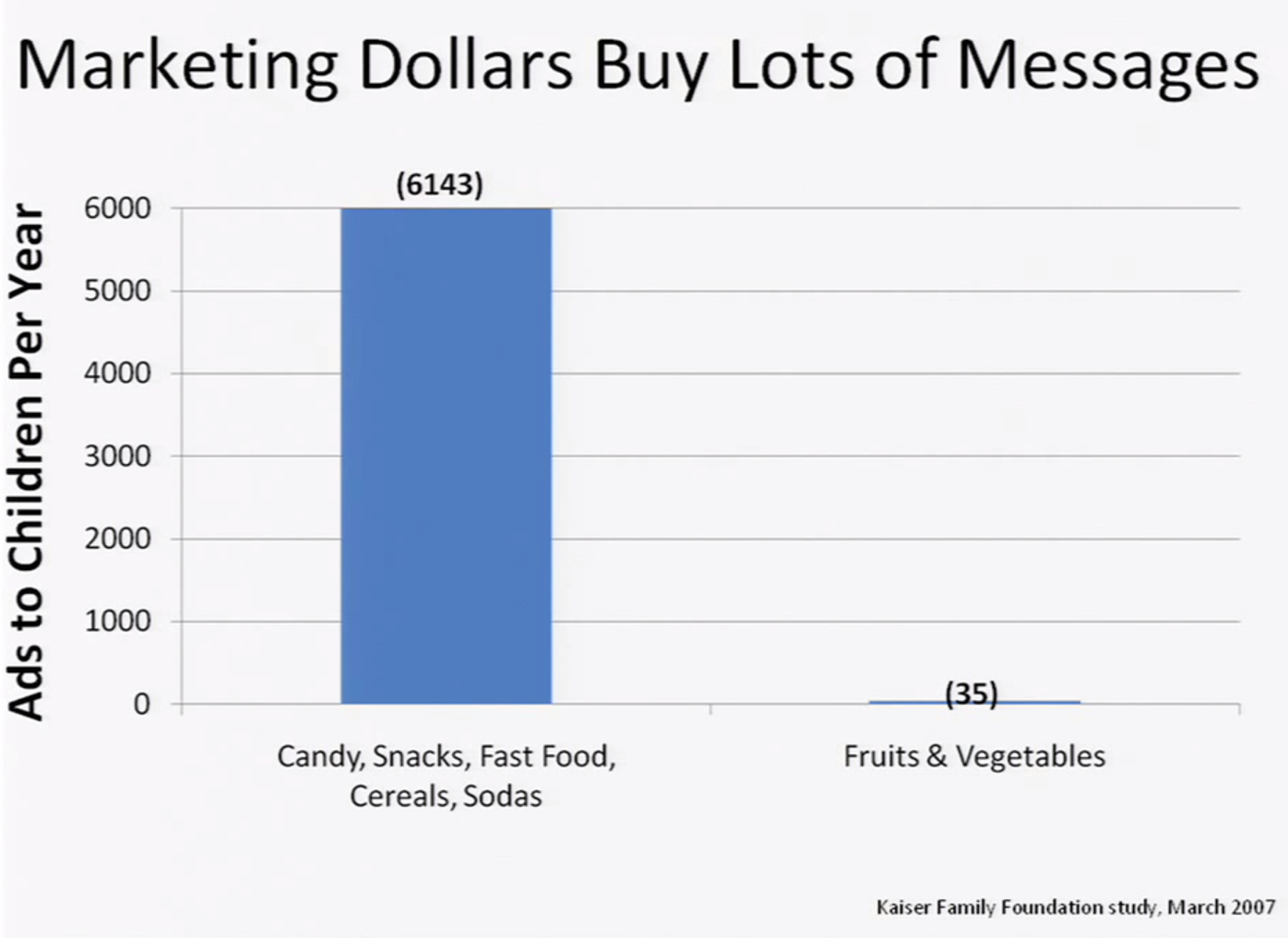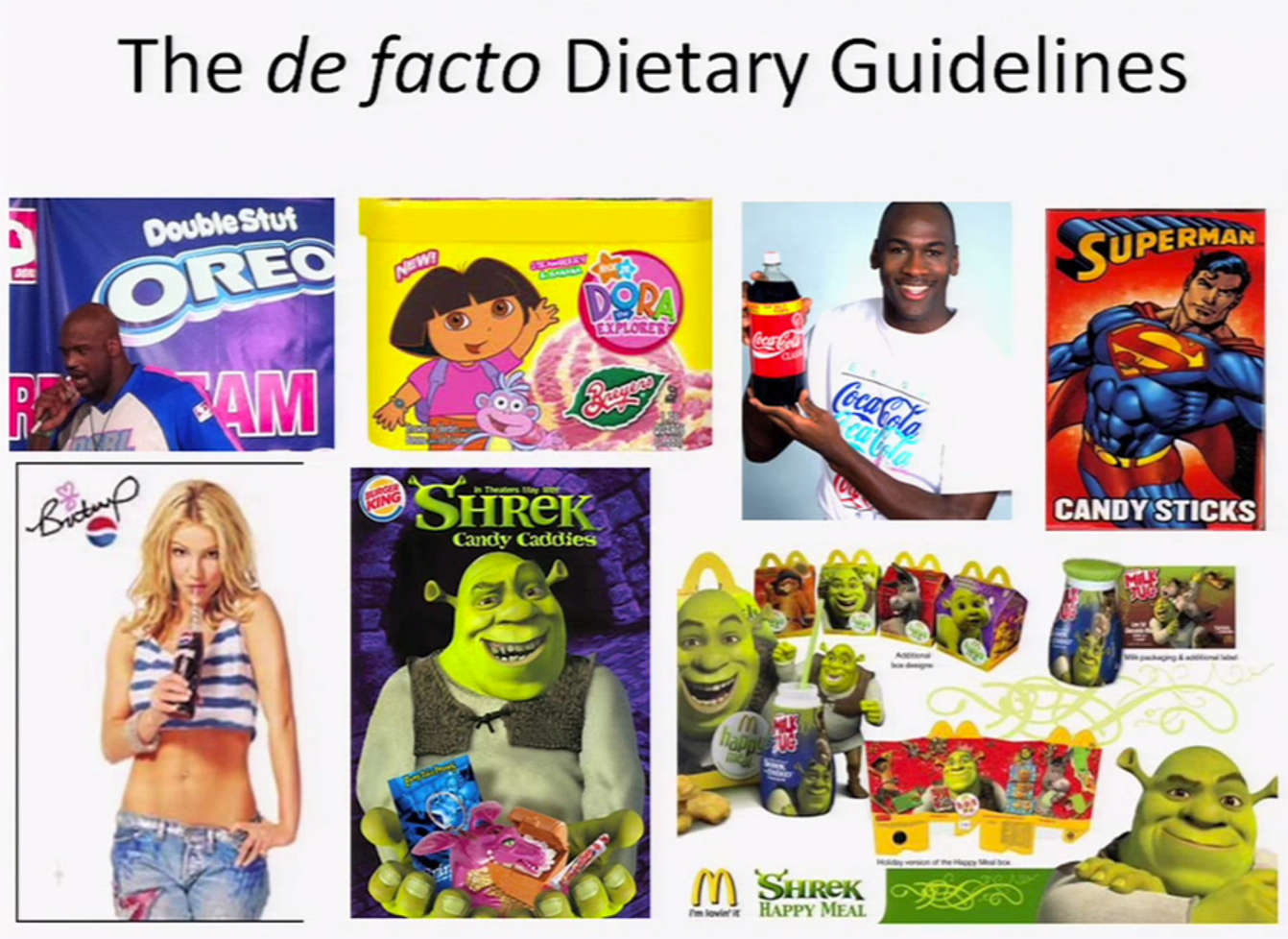|
![]()
| Targeting advertising at children Example1 #368175 Advertising and other marketing approaches are targeted at children and other vulnerable groups. | 

Sources: Scott Kahan, Kaiser Family Foundation 
|
+Citations (5) - CitationsAdd new citationList by: CiterankMapLink[3] Influence of licensed spokescharacters and health cues on children's ratings of cereal taste
Author: M.A. Lapierre, S.E. Vaala, D.L. Linebarger
Publication info: 2011 March, Arch Pediatr Adolesc Med. 2011 Mar;165(3):229-34. doi: 10.1001/archpediatrics.2010.300
Cited by: David Price 10:59 AM 17 December 2014 GMT
Citerank: (3) 352388Advertising and marketing reinforce new eating patterns Marketing and advertising instil and reinforce new cultural norms about what (e.g. fast food) and how to eat (e.g. snacking), and how much (e.g. larger portions) to eat.555CD992, 399917Advertising and marketing reinforce new eating patterns Marketing and advertising instil and reinforce new cultural norms about what (e.g. fast food) and how to eat (e.g. snacking), and how much (e.g. larger portions) to eat.555CD992, 399945Targeting advertising at childrenAdvertising and other marketing approaches are targeted at children and other vulnerable groups.62C78C9A
URL: | | Excerpt / Summary > OBJECTIVE: To investigate whether licensed media spokescharacters on food packaging and nutrition cues affect young children's taste assessment of products.
> DESIGN: In this experimental study, children viewed 1 of 4 professionally created cereal boxes and tasted a "new" cereal. Manipulations included presence or absence of licensed cartoon spokescharacters on the box and healthy or sugary cereal name.
> SETTING: Shopping center in a large northeastern city in December 2007.
> PARTICIPANTS: Eighty children (mean [SD] age, 5.6 [0.96] years; 53% girls) and their parents or guardians.
> MAIN EXPOSURE: Licensed cartoon characters and nutrition cues in the cereal name.
> OUTCOME MEASURES: Children rated the cereal's taste on a 5-point smiley face scale (1, really do not like; 5, really like).
> RESULTS: Children who saw a popular media character on the box reported liking the cereal more (mean [SD], 4.70 [0.86]) than those who viewed a box with no character on it (4.16 [1.24]). Those who were told the cereal was named Healthy Bits liked the taste more (mean [SD], 4.65 [0.84]) than children who were told it was named Sugar Bits (4.22 [1.27]). Character presence was particularly influential on taste assessments for participants who were told the cereal was named Sugar Bits.
> CONCLUSIONS: The use of media characters on food packaging affects children's subjective taste assessment. Messages encouraging healthy eating may resonate with young children, but the presence of licensed characters on packaging potentially overrides children's assessments of nutritional merit.
|
Link[4] Why we eat the way we eat
Author: Scott Kahan
Publication info: 2011 June, 3
Cited by: David Price 11:03 AM 17 December 2014 GMT
Citerank: (15) 352388Advertising and marketing reinforce new eating patterns Marketing and advertising instil and reinforce new cultural norms about what (e.g. fast food) and how to eat (e.g. snacking), and how much (e.g. larger portions) to eat.555CD992, 352390Industrial way of life is obesogenicRapid societal changes—for example, in food production, motorised transport and work/home lifestyle patterns—have placed human physiology (which has evolved to cope with an under-supply of food and high energy expenditure) under new stresses, and revealed an underlying genetic tendency to accumulate and conserve energy (i.e. gain weight) in a high proportion of the population. In this sense, obesity can be construed as a normal physiological response to an abnormal environment.555CD992, 370363Unhealthy foods are cheaper and getting cheaper555CD992, 370364Portions have grown larger555CD992, 370365Unhealthier foods are engineered to be tastierFood scientists have become adept at understanding how our brains respond to, and react to, and crave tastes, smells and textures, and have become adept at engineering and processing foods to take advantage of that – largely by adding lots of salt, sugar and fat – and to make these foods almost irresistible to our brains.555CD992, 370366Ready-to-eat food is more readily availableReady-to-eat food is increasingly available in industrial societies 24-hours a day and in places where food wasn't traditionally available (such as pharmacies and petrol stations), as well as via the growing number of fast food restaurants and coffee shops.555CD992, 371727Growth in restaurants and dining outThe restaurant industry has almost doubled its share of every dollar spent on food in the United States over the last 60 years from 25% in 1955 to 47% today. Much of this growth reflects the expansion in fast food restaurants (a trend observed in other countries including the UK).648CC79C, 399889Industrial way of life is obesogenicRapid societal changes—for example, in food production, motorised transport and work/home lifestyle patterns—have placed human physiology (which has evolved to cope with an under-supply of food and high energy expenditure) under new stresses, and revealed an underlying genetic tendency to accumulate and conserve energy (i.e. gain weight) in a high proportion of the population. In this sense, obesity can be construed as a normal physiological response to an abnormal environment.555CD992, 399917Advertising and marketing reinforce new eating patterns Marketing and advertising instil and reinforce new cultural norms about what (e.g. fast food) and how to eat (e.g. snacking), and how much (e.g. larger portions) to eat.555CD992, 399918Unhealthy foods are cheaper and getting cheaper555CD992, 399919Portions have grown larger555CD992, 399920Unhealthier foods are engineered to be tastierFood scientists have become adept at understanding how our brains respond to, and react to, and crave tastes, smells and textures, and have become adept at engineering and processing foods to take advantage of that – largely by adding lots of salt, sugar and fat – and to make these foods almost irresistible to our brains.555CD992, 399921Ready-to-eat food is more readily availableReady-to-eat food is increasingly available in industrial societies 24-hours a day and in places where food wasn't traditionally available (such as pharmacies and petrol stations), as well as via the growing number of fast food restaurants and coffee shops.555CD992, 399945Targeting advertising at childrenAdvertising and other marketing approaches are targeted at children and other vulnerable groups.62C78C9A, 399947Growth in restaurants and dining outThe restaurant industry has almost doubled its share of every dollar spent on food in the United States over the last 60 years from 25% in 1955 to 47% today. Much of this growth reflects the expansion in fast food restaurants (a trend observed in other countries including the UK).648CC79C URL: |
Link[5] Why McDonald's says it wants "to be in the schools"
Author: Aimee Picchi
Publication info: 2014 December, 11
Cited by: David Price 10:13 PM 17 December 2014 GMT
Citerank: (1) 399945Targeting advertising at childrenAdvertising and other marketing approaches are targeted at children and other vulnerable groups.62C78C9A
URL:
| | Excerpt / Summary If McDonald's (MCD) has its way, the three R's might end up being reading, writing and Ronald McDonald.
That's because the fast-food giant is planning to refocus on marketing to children and families in response to a serious problem on its plate. Thanks to changing tastes, the fast-food chain has suffered seven straight months of declining U.S. sales, with parents increasingly opting for rivals' seemingly healthier meals.
Its ambitious plan to polish the tarnished golden arches, as revealed in an investor conference call this week, involves a push toward getting families and kids back in its restaurants, with the chain's U.S. president telling investors that the company will "start with mom and we will be helping her to feel great about McDonald's -- whether it's McTeacher's Nights, sponsoring kids sports, being a visible partner in local initiatives."
Given that America is facing an obesity epidemic, involving McDonald's in schools and in children's sports events is "a bad plan for children's health," Sriram Madhusoodanan, an organizer at Corporate Accountability International, told CBS MoneyWatch. "This is really about McDonald's using an institution that parents and children trust -- our teachers and schools -- to provide an additional veneer of healthfulness." |
|
|